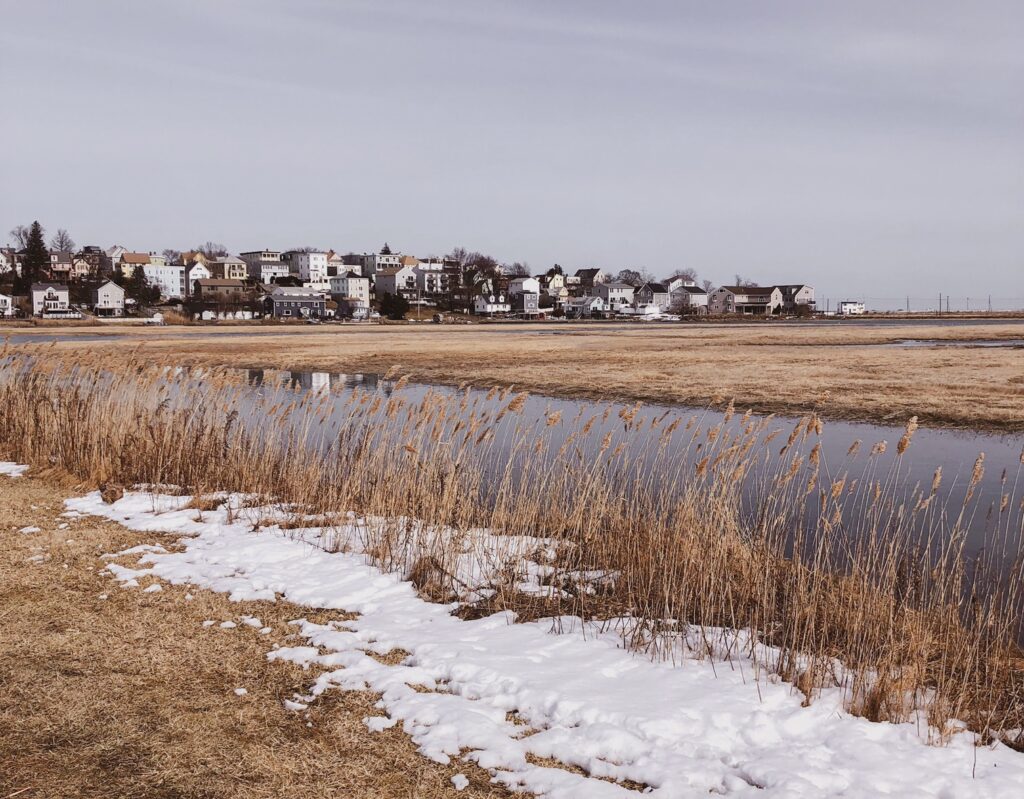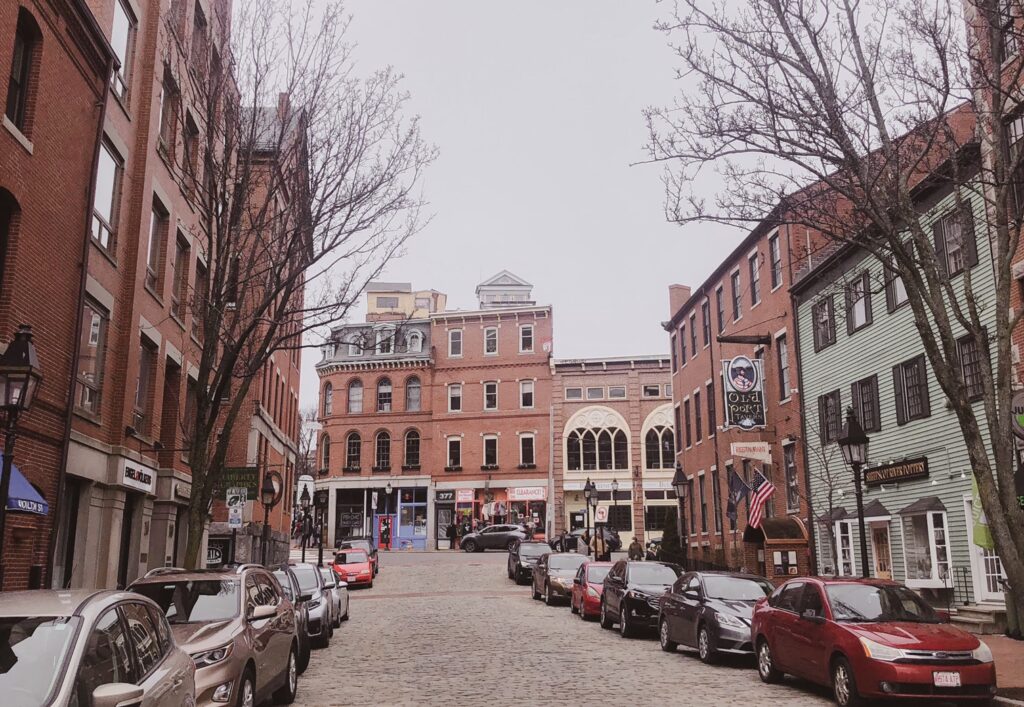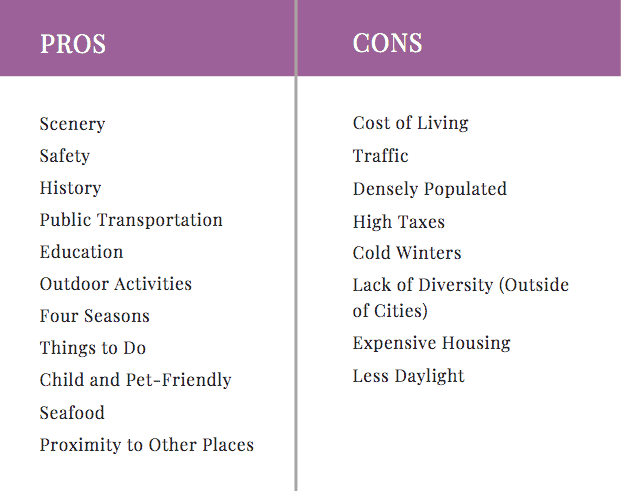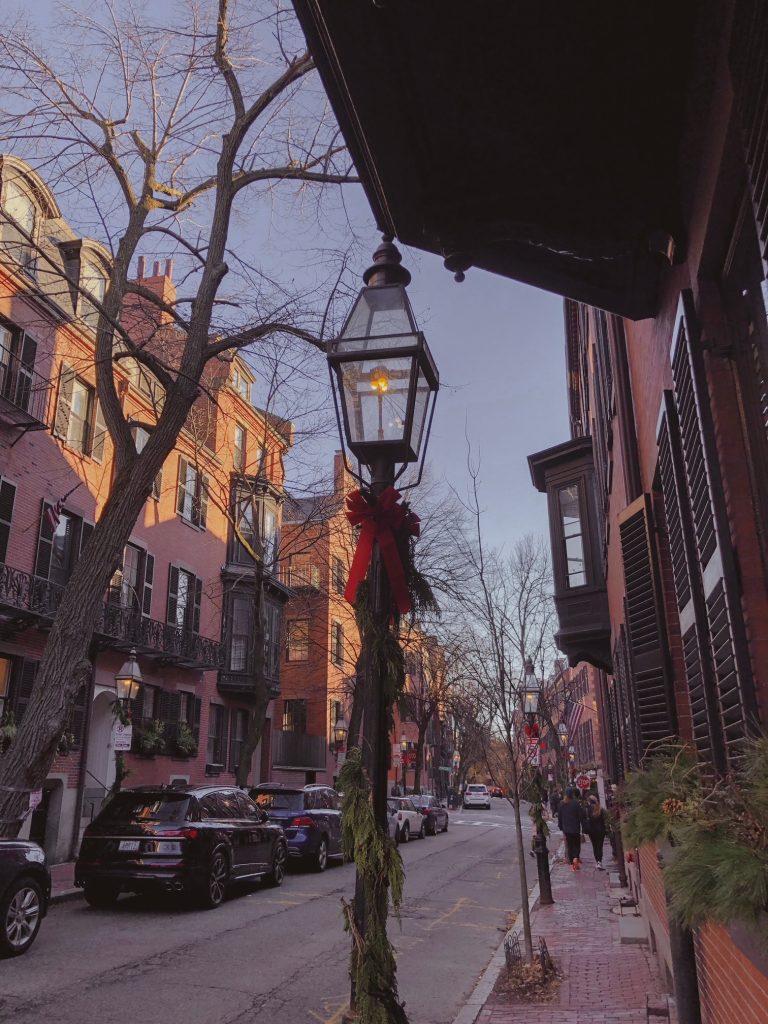19 Pros and Cons of Living in New England
Are you thinking about moving to New England?
Several things likely come to mind when you think of New England, such as the ocean, fresh seafood, revolutionary history, and quaint small towns. It’s one of the most picturesque and iconic regions of the U.S. for good reason. But what are the pros and cons of living here?
Keep reading for a list of 19 pros and cons to help you decide if living in New England is for you!

19 Pros and Cons of Living in New England
Here is my list of 19 pros and cons of living in New England, after experiencing life here for the last four years:
1. Pro: The scenery is breathtakingly beautiful.
I list the scenery as the very first pro about New England because it is my favorite thing about living here. New England may be a small region of the country, but it packs a variety of landscapes inside its borders.
Along the coast from Rhode Island up to Maine, you have breathtaking vistas of the Atlantic Ocean from the rocky, jagged shoreline. In Maine, New Hampshire, and Vermont, you can hike or ski in the mountains.
In Massachusetts and Connecticut, you can enjoy the rolling hills and winding roads leading through historic towns. And in northern Vermont, you will find the stunning Lake Champlain, New England’s largest lake.
2. Con: The cost of living is ridiculously expensive.
Unfortunately, to enjoy the beautiful scenery of New England is very expensive. Four of the six New England states rank in the top 10 most expensive U.S. states to live (Massachusetts, Connecticut, Rhode Island, and Vermont).
Massachusetts is the fourth most expensive state in the nation, with housing that costs 77% more than the national average. Boston, in particular, is extremely expensive, with rent that is triple the state average.
The costs of other living expenses, such as groceries and healthcare, are also significantly higher than national averages.

3. Pro: It’s one of the safest regions of the United States.
New England as a whole is very safe compared to other parts of the U.S. Vermont ranks as the safest state in the country, with the lowest violent crime rate. The other five New England states are all in the list of the top 10 safest U.S. states as well.
I remember going on a family vacation in Maine as a kid and the owner of the house we were renting told us not to bother locking the doors when we were out and about.
That was more than 20 years ago, so I doubt people are as trusting today. But New England still has a reputation for being quite safe.
4. Con: The traffic is terrible.
Driving in New England is an adventure. You never know quite what you’re going to get when you venture out of the house. In Michigan where I am originally from, the distance in miles is generally equal to the number of minutes it takes to arrive to your destination (10 miles = 10 minutes).
In New England, especially the more urban areas like Boston or New Haven, the amount of time it takes to get anywhere could vary greatly from day to day, or even hour to hour.
(Let’s be honest, sometimes it’s even minute to minute. If I leave for my daughter’s daycare five minutes later than usual, I could end up in a completely different flow of traffic and lengthen my trip by 15 minutes or more.)
Not to mention, New England drivers are very impatient and a bit reckless. I saw some of the worst drivers in my life when I lived in New Haven, Connecticut. People ran through red lights all the time. (Like, they actually stopped and then proceeded through the red light if they saw no one was coming.)
In Massachusetts, if you wait more than a millisecond to put your foot on the gas after a light turns green, expect to be honked at. And beware the infamous rotaries (traffic circles), which for me always seem like a game of survival of the fittest.
For what it’s worth, I have found drivers to be more polite in northern New Hampshire and Maine, where the population isn’t as dense and you aren’t as likely to get stuck in traffic.

5. Pro: History comes alive here.
If you’re a history buff, you will love exploring the history of New England, which is well preserved through a plethora of historic sights and monuments.
There are parts of New England that seem almost unchanged from the colonial days of more than 400 years ago.
See the place where the pilgrims first arrived from England in Plymouth, Massachusetts. Explore Concord and Lexington, Massachusetts, the sites of key battles during the Revolutionary War. Walk the 2.5-mile Freedom Trail in Boston for more important sites before and during the Revolutionary War.
You can also learn about the Native American tribes of New England through museums and historic sights available in all six states, including the Institute for American Indian Studies in Connecticut and the Tomaquag Museum in Rhode Island.
6. Con: It’s very densely populated.
The population of New England is nearly 15 million, and the land area is about 72,000 square miles. By comparison, the state of Utah is 85,000 square miles with a population of only 3.3. million. There are a LOT of people crammed into a small space in New England.
Most of the population is in the small states of Massachusetts (7 million) and Connecticut (3.6 million), with one-third of New England’s population in the Greater Boston area. (And there are 1 million people in teeny-tiny Rhode Island!)
That’s why traffic is so bad in these areas, and parking can also be a nightmare. It’s not uncommon to circle around for a while to find an open metered space, or settle on parking in an expensive garage. It’s also why public transportation is often a preferred mode of transportation.
But not all of New England feels this crowded. You’ll find more open spaces in New Hampshire, Vermont, and Maine. That’s where other New Englanders like to escape on the weekend, too.

7. Pro: There is an excellent public transportation system.
New England has one of the best public transportation systems in the country. Especially in urban areas of Massachusetts and Connecticut, you can easily get around by taking a train or bus instead of a car.
Did you know Boston’s MBTA (“The T”) is the third-oldest subway in the world and the very first one in North America? While it’s not the most efficient subway I’ve experienced, it does extend far into the North and South Shores of Massachusetts, making it an effective way to explore a lot of the state without a car.
8. Con: It is one of the most heavily taxed regions of the country.
Massachusetts and Connecticut, in particular, rank #2 and #4 for having the highest effective tax rates in the U.S.
The median annual income is higher than average in these states as well, which may even things out if your employer resides in these states. But if you’re a remote worker like me, this additional tax burden can be painful.

9. Pro: Some of the world’s best schools can be found here.
There is at least one world-class college or university in every state in New England, including some of the most prestigious ivy league schools:
- Massachusetts: Harvard University, Massachusetts Institute of Technology, Boston College, Amherst College, Tufts University, Wellesley College, Boston University, Brandeis University
- Connecticut: Yale University, Wesleyan University, University of Connecticut
- New Hampshire: Dartmouth College, University of New Hampshire
- Rhode Island: Brown University, University of Rhode Island
- Maine: Colby College, Bowdoin College, Bates College
- Vermont: Middlebury College, University of Vermont
New England is a great place to live if you or one of your family members plans to study at one of these schools.
10. Con: Winters are cold and snowy.
If you don’t like winter, you won’t enjoy living in New England. While I have found winter in New England to not be as extreme as in the Midwest, there is still a lot of snow.
You can also count on having cold temperatures for at least three months out of the year, from mid-December until mid-March.
Additionally, driving in New England in the winter is not fun, especially if you live in an urban area where the traffic is bad. If you live in Boston, parking in the winter gets even more fun.

11. Pro: There are many opportunities to explore the great outdoors.
Outdoor enthusiasts will be on cloud nine in New England. There is an endless number of hiking trails, ski resorts, beaches, biking and running trails, and more to satisfy any type of athlete.
Even if you aren’t very athletic, you will benefit from the many opportunities to walk and explore in nature. Each New England state takes great care in preserving its many state parks and reservations to ensure they will last for generations to come.
Some of the best outdoor areas in New England include:
- Acadia National Park, Maine
- Cape Cod, Massachusetts
- White Mountains, New Hampshire
- Devil’s Hopyard State Park, Connecticut
- Newport to Narragansett, Rhode Island
- Green Mountains, Vermont
12. Con: Outside of Boston and other metro areas, the population isn’t very diverse.
Cities such as Boston and New Haven have diverse populations with people from all over the world, but once you venture outside of the cities, the populations are comparatively very white.
If you are looking for a “melting pot” situation, you won’t find it in many parts of New England, especially Vermont (92% white*), New Hampshire (89% white), and Maine (93% white).
By comparison, Massachusetts is 70% white, Connecticut is 65% white, and Rhode Island is 70% white.
*White means not Hispanic or Latino. Data taken from U.S. Census Bureau website.

13. Pro: You get to experience all four seasons equally.
New England has a fairly equal balance between all four seasons, which is great if you’re like me and enjoy the seasonal variation.
Each season generally lasts about three months, with winter from mid-December to mid-March, spring from mid-March to mid-June, summer from mid-June to mid-September, and fall from mid-September to mid-December.
You can expect to see gorgeous flowering trees in the spring, have warm and sunny beach weather in the summer, observe a stunning kaleidoscope of leaf colors in the fall, and experience at least one or two good snow storms in the winter.
14. Con: It has one of the most unaffordable housing markets in the country.
If you’re looking to snag a deal on a house, New England should not be the first place you turn to, especially Massachusetts and New Hampshire. Below are the average home prices in each New England state (according to Zillow):
- Connecticut: $361,000
- Maine: $372,000
- Massachusetts: $579,000
- New Hampshire: $446,000
- Rhode Island: $436,000
- Vermont: $386,000
By comparison, the average home price in Michigan is $236,000 and in Georgia it’s $325,000.
At the same time, New England currently has one of the hottest real estate markets in the country, meaning you’ll be in for some stiff competition when searching for a house.

15. Pro: You will never run out of things to do.
The southern part of New England—Massachusetts, Connecticut, and Rhode Island—is densely populated and diverse, meaning there is a never-ending list of restaurants, festivals, concerts, museums, and galleries to check out.
When I open my Joyraft app for Boston, there always seems to be a million things happening in the city on any given day.
In the northern part of New England, you’ll be in a natural paradise where you’ll never run out of places to explore. I have been to several parts of Maine, Vermont, and New Hampshire and feel like I have only scratched the surface of each state.
Travel up and down the coast of New England and you’ll come across dozens of different beaches offering their own unique perspective of the sea—and seafood.
And because of the seasonal variation, you get to enjoy different types of activities throughout the entire year, from swimming and hiking to dining in igloos and ice skating.
All that to say, it’s hard to get bored in New England.
16. Con: It gets dark earlier in the day.
This continues to be one of the hardest parts for me about living in New England. In Michigan, I was used to it being light outside until close to 10 p.m. in the summer and around 5:30 p.m. in the winter.
In New England, the latest the sun sets in the summer is around 8:30 p.m., and in the winter, sunset is shortly after 4 p.m.
I didn’t think this difference in daylight would be such a big deal, but four years later, it’s still hard for me to adjust. In the winter, I just want to hibernate for three months and count down until spring when the sun comes out a little longer.

17. Pro: It’s a great place for children and pets.
Aside from the high cost of living, New England is a great place to raise a family. There are plenty of educational opportunities and kid-friendly activities available. Not to mention all the outdoor spaces for kids to explore and get some fresh air.
My toddler absolutely loves going to the beach and this has become one of our easiest, favorite activities to do in the summer. Pretty much every New England town I have visited also has at least one nice playground for her to get her energy out.
In the winter, there is an abundance of sledding hills and ice skating rinks, as well as children’s museums for kids to learn in fun, interactive ways.
New England is also very pet-friendly. I see people walking their dogs everywhere, and there are lots of daycares and grooming shops. Boston, in particular, seems to be a haven for people with pets. The Boston Common is always filled with people who let their dogs run free.

18. Pro: Taste some of the best seafood in America.
I ran out of cons of living in New England, so these last two items are some bonus pros. 🙂
It’s probably no surprise that the seafood is one of the biggest perks of living in New England. If you enjoy freshly caught meals from the sea, you will be in heaven here. From lobster and clams to oysters and every variety of fish, you can sample to your heart’s content.
Seafood is more than just something to eat in New England. For many people, it’s a lifestyle. There is an abundance of restaurants serving the catch of the day, and it’s a great chance to meet locals and learn about the history of the place. Some restaurants have been around for a hundred years or longer.
A few popular options include:
- Union Oyster House, Boston, Massachusetts
- Turner’s Seafood Market, Gloucester, Massachusetts
- The Mariner, Mystic, Connecticut
- Lenny’s Indian Head Inn, Branford, Connecticut
- The Porthole, Portland, Maine
19. Pro: There are many amazing destinations within close proximity.
One of the things I love most about living in New England is how many interesting places there are to visit within a short distance.
- If you want a peaceful beach escape, go to Cape Cod, Martha’s Vineyard, or Nantucket.
- For long hikes in the mountains, visit the Green Mountains of Vermont, the White Mountains of New Hampshire, or Acadia National Park in Maine.
- For a day on the lake, travel up to Vermont’s Lake Champlain. While you’re at it, you could even jump over the border to explore Montreal and Quebec City, Canada.
- Boston is a fun city to visit over and over again as there are always different events and festivals taking place.
- And if you’re craving the big city, New York City isn’t very far away either.
Boston Logan Airport is also a great gateway to other parts of the U.S. and overseas. You can sometimes snag a nonstop flight to Iceland for just a couple hundred dollars!

FAQs
Here are answers to some frequently asked questions about New England:
Is New England a good place to live?
New England is a desirable place for many people because of its proximity to the ocean, its many world-class universities and reputable companies, and its well-preserved history.
Cities like Hartford, Connecticut and Boston, Massachusetts rank for having some of the highest quality of life in the U.S.
If you can manage the higher cost of living, the traffic (depending on where you live), and the cold winters, New England is a great place to live.
What do you need to know before moving to New England?
It’s a good idea to weigh the pros and cons of living in New England that I include in this post to decide if New England would be the right fit for you.
I recommend working with a real estate agent for help in finding the best place to live—something that will both fit your budget and be in a location you will enjoy.
It’s also important to know that life in the southern part of New England is different than in the north.
If you like the energy and opportunities of urban life, you’ll likely be happier in Rhode Island, Connecticut, or Massachusetts. If you’d prefer a slower pace of life, look into Vermont, New Hampshire, or Maine.
Which state in New England is the best to live in?
This really depends on what you are looking for:
- Vermont currently ranks as the safest state in the U.S. and has a more affordable cost of living than other parts of New England, but it’s also more rural.
- Massachusetts, especially the Greater Boston area, is densely populated and always has plenty of concerts, festivals, and other events going on. You’ll also find some of the best beaches here.
- Connecticut is closest to New York City, Philadelphia, and other locations outside of New England. Cost of living is also lower than its sister states, Massachusetts and Rhode Island.
- Rhode Island is expensive to live in but is absolutely beautiful. It’s called the Ocean State for a reason. Since it’s so small, you also would not be far from Boston, New Haven, and New York.
- New Hampshire has the best of both worlds: ocean in the east and mountains in the west. It’s a great place to live if you enjoy the outdoors.
- Maine is also a great place for nature lovers and is even more rural than New Hampshire and Vermont. Since it’s the farthest north of all the New England states, you’ll really feel like you’re “away from it all.”
Where are the best cities to live in New England?
Boston, Massachusetts is the largest city in New England and is sometimes called the “Hub of the Universe.” It really does feel like the center of life in New England. There’s always lots to do here, and it’s one of the best starting points to get to most other places in New England as well.
It’s very expensive to live in Boston, so many people choose to live in one of the suburbs and easily commute in via the T (Boston’s subway). Watertown, Somerville, and Newton are a few nice Boston suburbs.
Hartford, Connecticut also ranks high for its quality of life and its close proximity to Boston, New York, and other prime destinations in New England and beyond. The cost of living is much more affordable there than in Boston.
Providence, Rhode Island is the state’s largest city and is known for its food and art scene. It’s also not far from Newport, a popular seaside town in New England.
Portland, Maine is another favorite place for foodies and art lovers. It’s Maine’s most populous city and within easy driving distance from Boston to the south, the White Mountains to the west, and Acadia National Park to the north.
Is New England similar to England?
There are actually some striking similarities between New England and England. I’ve compiled a list of these similarities in this post. At the same time, there are several obvious differences between both places, which I talk about as well.
In short, New England is similar to England when you look at things like the old architecture and winding, narrow streets. And if you’ve experienced coastal England, you might notice similarities in the landscape and seafood options.
But when it comes to the overall culture and language, New England and England are still quite distinct.
Conclusion: Pros and Cons of Living in New England
Hopefully this list of pros and cons of living in New England will help you decide if this is where you want to call home!
For a quick recap, here are the pros and cons I covered in this post:

Want to learn more about New England? Check out these other posts:
- Similarities (and Differences) Between New England and England
- The Perfect 7-Day New England Road Trip from Boston
- 24-Hour Boston Itinerary: Best Things to Do in 2023
- Massachusetts in Winter: Things to Do, Places to Visit, and More
- A Weekend in Newport, Rhode Island: 7 Best Things to Do
- Best Time to Visit New Hampshire 2023: Fall Foliage, Summer Fun, and More







